Back to the Mac: OS X 10.7 Lion Review
by Andrew Cunningham, Kristian Vättö & Anand Lal Shimpi on July 20, 2011 8:30 AM ESTLion introduces some new multi-touch gestures for the owners of a MacBook with a multi-touch trackpad, Magic Trackpad or Magic Mouse.
Trackpad
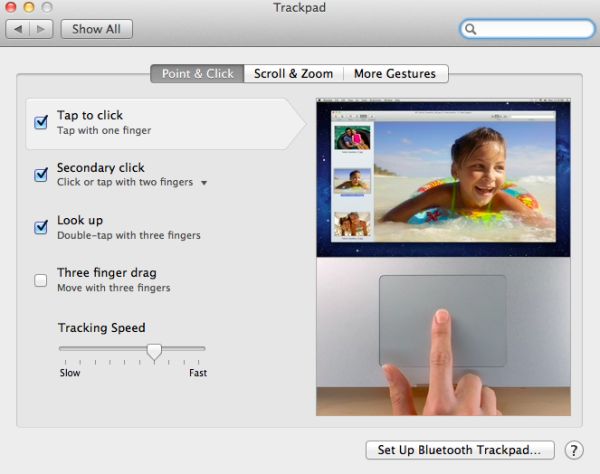
There are 14 gestures, divided into three categories: Point & Click, Scroll & Zoom and More Gestures. The first two new ones are under the Point & Click tab and they are called Look Up and Three finger dragging. The former is triggered by double-tapping with three fingers and it allows you to look up a word in the dictionary. Thee finger drag is fairly obvious and enabling it lets you drag windows with three fingers.
In Scroll & Zoom, you are provided four options of which two are new. The first option is Scroll direction and enabling it will make scrolling “natural.” Natural means the content follows your finger movement, so if you scroll down, the content will move up, just like In iOS. Natural scrolling is enabled by default but you can disable it to get back the old normal scrolling (finger moves down, content moves down). The next new option under Scroll & Zoom tab is Smart zoom. It's triggered by double-tapping with two fingers and as a result, the window will be zoomed to focus on the content you just double-tapped (e.g. Picture).
The final tab is More Gestures. The first gesture is Swiping between pages, which isn’t actually a new gesture but the animation is different. When you perform this gesture, it looks like the page is vanishing to either right or left, which is pretty cool. In Snow Leopard, this gesture was limited to three fingers but Lion allows you to set it for two or three fingers. Next up is Swipe between full-screen apps. By default, this is done with three fingers but you can also set it to be done with four. This is a great feature for users of full-screen apps or Spaces because now you can easily scroll between your Spaces. Below full-screen app swiping is a gesture for Mission Control. In Snow Leopard, Exposé was triggered by swiping up or down with four fingers but in Lion Mission Control is limited to swiping up but with three to four fingers depending on what you choose. Swiping down with three or four fingers will enable App Exposé, which shows the open windows for certain application. Last but not least, you have two gestures that are done by pinching or spreading with your thumb and three fingers. Pinching triggers Launchpad, while spreading shows your desktop.
Magic Mouse
With the Magic Mouse, the number of gestures is limited to six. The gestures are divided into two categories: Point & Click and More Gestures.
Point & Click offers three gestures in addition to tracking speed bar. The first one is Scroll direction which behaves exactly the same with the Magic Mouse as it does with the trackpad. The second one is secondary click, which is present in Snow Leopard as well. The third one is Smart zoom, which again is the same as the trackpad and can be enabled by double-tapping with one finger.
The More Gestures tab provides three more gestures: Swipe between pages, Swipe between full-screen apps and Mission Control. These are yet again similar to the gestures with trackpad, the only difference is the actual gesture. Swiping between pages can be done by scrolling left or right with one or two fingers. Swiping between full-screen apps is performed by swiping left of right with two fingers, there are no other options. Mission Control is triggered by double-tapping with two fingers.


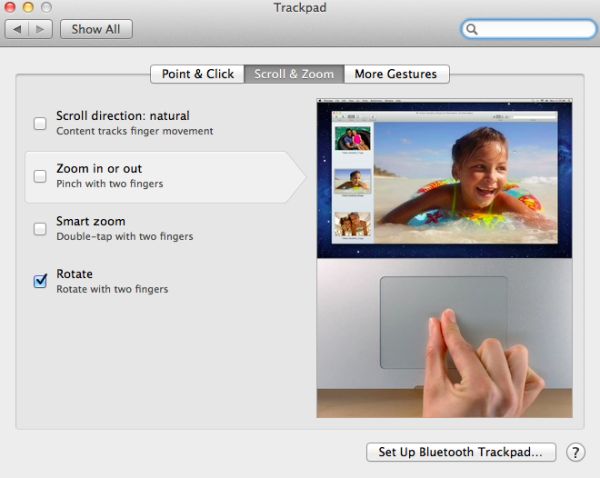
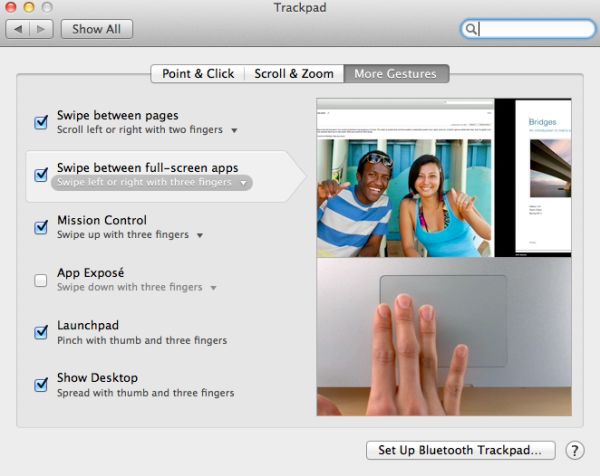
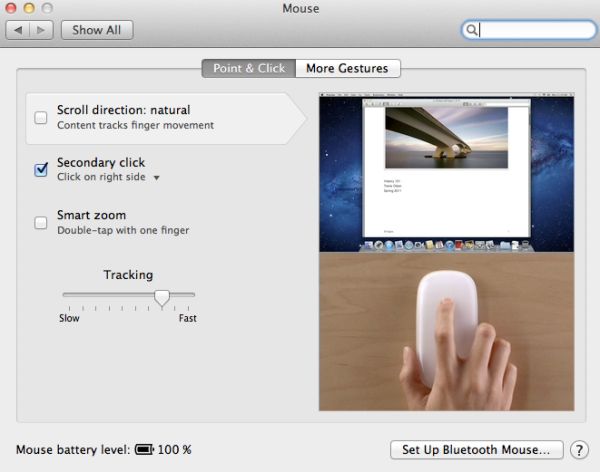
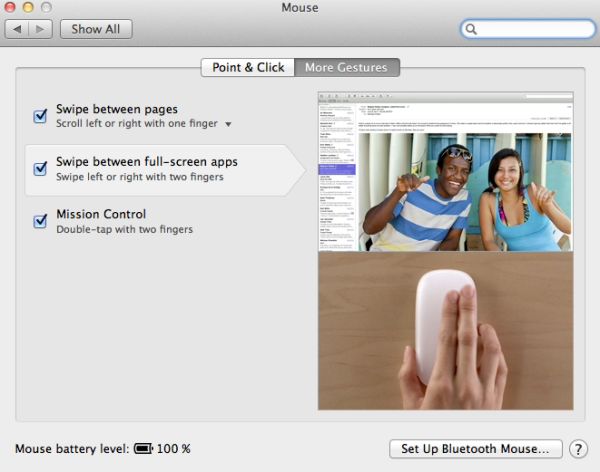








106 Comments
View All Comments
rs2 - Wednesday, July 20, 2011 - link
Okay, it makes sense on a touch device where your finger is actually making contact with the thing you are scrolling. But a mouse cursor is *not* a finger. It is not an analog for a finger. It is a different input paradigm entirely, and trying to make it behave as if the mouse cursor is your finger by making scrolling go backwards is stupid.It's good that they put in an option to disable the nonsense that is "natural" scrolling.
name99 - Thursday, July 21, 2011 - link
Not at all. The issue is simple : what is the metaphor?When I move my finger, am I moving
- the window container? OR
- the content?
Claiming that one is more "natural" than the other is as stupid as claiming that English is more natural than Chinese. It's simply that you are used to one and, like a good American, you simply cannot imagine that the world could possibly be different --- after all, Jesus spoke English.
rs2 - Thursday, July 21, 2011 - link
Not at all. There is no "finger" when using a mouse. Touch and mouse-driven are distinct input paradigms. If a touch-based interface ever scrolled content in the opposite direction that the user moved their finger, then people would say that it was broken. And rightly so. Moving content in the same direction as the touch is the intuitive operating mode of a touch interface.And similarly, moving content in the opposite direction of the scroll (or more accurately, moving the scrollbar in the same direction of the scroll) is the intuitive operating mode for a mouse-driven interface. By your logic scrollbars themselves should also be inverted.
As a side-note, a direct analog to touch style scrolling does exist in the mouse-driven paradigm, it is the drag operation. It is available in some things like Adobe PDF documents, and also work on any scrollbar. In this operation you choose an anchor-point, and then that anchor point moves in the same direction that you move, and it all makes sense. The problem with scrolling is that it has no anchor point, it is a distinct operation from a drag operation, and by conflating the two Apple has broken their interface. At least until they start incorporating touch into every computer they sell.
Mouse-driven and touch interfaces are not the same thing, and just because a metaphor makes sense in one does not mean that it also makes sense in the other.
Uritziel - Friday, July 22, 2011 - link
Agreed.CharonPDX - Wednesday, July 20, 2011 - link
On page 23 "Performance: Similar to Snow Leopard", you have a couple bar graphs comparing Snow Leopard to Lion performance. Unfortunately, you use a generic "compared to before as 1.0" metric, with no indication on a per-test basis whether higher or lower is better. In the Core 2 Duo graph, you talk about boot time skyrocketing, and the boot time graph for Lion shows Lion as "about 1.4" of Snow Leopard, yet you also talk about iPhoto having a "greater than 10% increase in performance", where the graph shows "about 1.1" of Snow Leopard. So in one line in the graph, higher is worse, in the other line, higher is better.You either need a per-test identifier (Higher is better / Lower is better) or you need to to standardize them all (so 'benchmark' ones would stand as-is, while 'timing' ones would use the inverse, so that both would be 'higher is better', or example.)
Deaffy - Thursday, July 21, 2011 - link
Did anyone check to see whether Apple has included a UI element to enable IPv6 privacy extensions for statelest address autoconfiguration?And did DHCPv6 to get IPv6 addresses from your ISP's cable via IPv6 finally make it's entry?
Deaffy - Thursday, July 21, 2011 - link
Oh yeah, and maybe the ability to query a name server via IPv6?kevith - Thursday, July 21, 2011 - link
they are more and more returning to the Linux it came from. Who knows, they might even go bact to open source:-)Omid.M - Thursday, July 21, 2011 - link
Anand/Andrew/Christian,If you right click on a YouTube video, does it say the rendering AND decoding is "accelerated" ? I thought Lion was supposed to bring that.
If this is now the case, it'd be enough reason for me to buy Lion and a new MBP 15". I can't stand the fans on my 2008 MBP 15 going nuts every time I watch a 30 second YouTube clip. The laptop gets unreasonably hot right now.
@moids
P.S. I'm not a fan of the way buttons appear on the upper borders of windows. There's no typical button "design" to signify that the text is clickable, at least not from the screen shots I saw in the article.
Omid.M - Thursday, July 21, 2011 - link
I guess it's disabled:http://www.macrumors.com/2011/07/21/adobe-suggests...